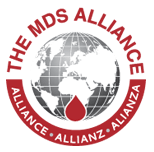Another update….
Home Demo › forums › Patient Message Board › Another update….
- This topic has 7 replies, 1 voice, and was last updated 18 years, 10 months ago by
KP2112.
-
AuthorPosts
-
June 6, 2005 at 11:00 pm #6669
Kathryn
MemberHi everyone,
today my father went to his hemotologist today and his counts were back down to 5. Last Monday he rec’d. 2 bags… It is strange though because this time his nose didn’t bleed at all… Every other time is has…
 Also supposedly his white count was down as well to 22…. I can’t figure out if that is good or bad…. When the cancer progresses to the acute phase can the white count also go down? I am still rather confused about the progression and what happens…..
Also supposedly his white count was down as well to 22…. I can’t figure out if that is good or bad…. When the cancer progresses to the acute phase can the white count also go down? I am still rather confused about the progression and what happens…..The doctor and my father decided to go ahead w/ the Trisenox treatment and he encouraged him to sign a Living Will…
 . The greater than 50% side effects are very concerning…. My dad is already quite weak and feels horrible…this could make it worse and at the same time could buy him some time…. I sure hope the benefits outweigh the risks and he will be able to enjoy the extra time…..
. The greater than 50% side effects are very concerning…. My dad is already quite weak and feels horrible…this could make it worse and at the same time could buy him some time…. I sure hope the benefits outweigh the risks and he will be able to enjoy the extra time…..I noticed that this isn’t a very common treatment so I thought it was important for me to share and will continue to as we go along…
Best wishes,
Kathryn
June 6, 2005 at 11:04 pm #6670Kathryn
MemberBy the way, the Trisenox treatment is injections for 5 days, then injections 2 days a week for 4 weeks, 2 weeks off and then re-evaluate.
Kat.
June 6, 2005 at 11:28 pm #6671Neil
MemberHi Kathryn,
Believe the d refers to Platelets? If this is the case maybe he actually had a higher platelet level
The equipment used to measure platelets is not all that accurate. Tolerance is 15000 on counts between 50,000 and 500,000. When they get down to 5000 its hard to tell. When my counts get that low my doc has a slide made and he manually counts them to be certain about what is going on.
Believe it is typical for white counts to go up with CMML. There are other forms of leukemia where they go down. Depends upon the type a given patient has. Both extremes can be bad. Much depend upon the differential. Neutrophil count is important. Esonophils and Basophils are generally not that significant—unles there is an agent attacking the body that they resist.
There are those patients who benefited from Trisonox. Spoke to a man some time ago that was tx independent for about a year. It has had some very good responses with minimal side effects. Lets hope he is one of those patients.
Its not all that uncommon a treatment, but with all the attention on Vidaza and Revlimid, Trisenox is taking a back seat.
NeilJune 6, 2005 at 11:29 pm #6672Terri
MemberKeeping your Dad in my prayers.
June 7, 2005 at 2:39 am #6673Kathryn
MemberNeil, glad to hear from you! Hope you are well.
Yes, I was refering to his platelet count. I am not sure how they count them. They just tend to run low. He rec’d. the medication via IV not injection. He will have a platelet tx. tomorrow and then a couple hours later will have his treatment. Neil, thank you for giving me some hope… It is scary reading all the side effects, so I am so glad to hear that it has made a positive difference in another’s life. Seems like from what I have read, they use this when other meds. aren’t effective.
Terri, your prayers must be working because he called me tonight and sounded considerably well!
 So far so good! He sounded optimistic, which is a very good sign… 1/2 the battle!!!
So far so good! He sounded optimistic, which is a very good sign… 1/2 the battle!!!Kathryn
June 7, 2005 at 3:01 am #6674Kathy G
MemberKathryn-
You and your Dad are in my prayers I hope he does well with this treatment – I can understand your concern. Hang in there and keep us posted on his progress.Kathy
June 7, 2005 at 3:05 pm #6675Jimbob
MemberKathryn,
With CMML the WBC count usually does exceed the normal range. When I was first dx’d, my WBC count was about 22K. When I had the extreme leukemic event it had shot up to 385K. After all of the chemo, radiation, etc, it was almost nontexistent – below 100 without the K! RBC were also killed off by the treatments. That is neccessary for new, healthy cell to replace the diseased cells. I am not familiar with the treatment that yoour dad is getting but it probably works in a similar way.
COntinued prayers for your dad and you.
JimJune 7, 2005 at 4:03 pm #6676KP2112
MemberKathryn,
Here is some information regarding Trisenox that I thought may be useful to you.
General Information
Trisenox (arsenic trioxide), injectable formulation, is indicated for the treatment of induction of remission and consolidation in patients with acute promyelocytic leukemia (APL) who are refractory to, or have relapsed from, retinoid and anthracycline chemotherapy, and whose APL is characterized by the presence of the t(15;17) translocation or PML/RAR-alpha gene expression.
Clinical ResultsA multi-center pivotal trial was held, led by Memorial Sloan-Kettering Cancer Center, consisting of 40 patients ranging in age from 5 to 72. The drug was shown to be effective with 70% of the patients achieving complete remission. 86% showed clearing of the chromosomal abnormality that causes APL. Total remission was reached, on average, within two months after treatment with Trisenox began. At a median follow-up time of 16 months, 68% of patients who had achieved complete remission were still alive and 58% were disease free.
Side Effects
Common side effects include, but are not limited to:
* leukocytosis
* nausea
* vomiting
* diarrhea
* abdominal pain
* fatigue
* edema
* hyperglycemia
* dyspnea
* cough
* rash or itching
* headaches
* dizzinessIn clinical trials these side effects usually did not require interruption of therapy, nor have they been observed to be permanent or irreversible.
Approx. 23% of patients showed symptoms of APL-differentiation syndrome during or after their treatment with Trisenox. These symptoms include fever, weight gain, shortness of breath, and musculoskeletal pain. High-dose steroids and diuretics were used to manage these symptoms and the majority of patients were able to continue their treatment with Trisenox. Hyperleukocytosis occurred in aprox. 50% of patients undergoing Trisenox therapy. It did not require them to stop treatment.
Mechanism of Action
The mechanism of action of Trisenox is not completely understood. Arsenic trioxide causes morphological changes and DNA fragmentation characteristic of apoptosis in NB4 human promyelocytic leukemia cells in vitro. Arsenic trioxide also causes damage or degradation of the fusion protein PML-RAR alpha. (From FDA Label)
Additional InformationFor more information about TRISENOX, please contact: • Professional Services: (800) 715-0944 Health care professionals can click on “Professional Services” above to request medical or drug information for TRISENOX. Normal business hours are 9:00 a.m. to 7:00 p.m., ET, Monday through Friday. After hours emergency coverage is also provided.
-
AuthorPosts
Register for an account, or login to post to our message boards. Click here.
- You must be logged in to reply to this topic.









